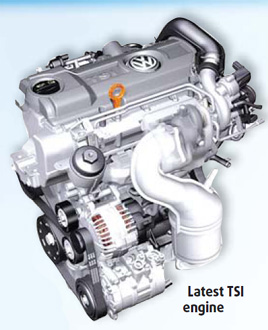

|
VW's New Golf, to be made in China this year, will be equipped with the new TSI engine. |
It seems a contradiction - delivering both full power and minimal fuel consumption - but the Volkswagen TSI engine offers an answer to the age-old automotive riddle.
One of the believers is Victor Wu, a Beijinger who bought his second car, a Volkswagen Magotan, six months ago.
"Although (the Magotan) is powered by a 1.8-liter engine, it is more powerful than my previous car with a 2.2-liter engine and it uses less fuel," he said. The reason for that is the new TSI engine.
Down through the auto giant's long history, Volkswagen's engineers have tried many approaches to solving the dilemma of power versus gas mileage. Their most cutting-edge solution today combines two leading technologies - direct fuel injection and turbo-charging - that led to the birth of the TSI engine.
Efficiency is now the watchword as the number of cars worldwide continues to surge - more than 1 billion vehicles are expected to be in use by 2011, according to research firm R.L. Polk.
Rising oil prices and increasing pressure for environmental protection have made new technologies crucial to global automakers.
New terms such as dual-mode, hybrid and fuel cell are now commonly used and understood, but technical maturity and production technology remain barriers to their large-scale commercial application.
Experts say the internal combustion engine will remain the dominant motor vehicle power plant for at least two more decades.
Volkswagen is working hard on the newest technologies, but it never abandoned its quest to further improve gasoline engines in use today. The TSI has further entrenched its leading position.
Fuel injection and turbo
The TSI combination of direct fuel injection and turbo-charging greatly enhances efficiency in burning fuel, which in turn delivers greater power.
A 1.8-liter TSI is able to produce more power than a 2.3- or 2.5-liter engine with conventional technology while using 10-15 percent less fuel. The resulting environmental performance means all Volkswagen TSI engines meet the EU V emission standard.
In addition, its core technologies are fully mature, so the TSI engine is more affordable and reliable than new energy powered vehicles.
Full series
In 2004, Volkswagen introduced the TSI engine with its fifth-generation Golf GTI. The engine conquered European consumers with its surging power as soon as it came to market and helped the Golf GTI further consolidate its leading position in its segment.
The TSI engine family has now grown to a large product series including the 1.2TSI, 1.4TSI, 1.8TSI and 2.0TSI. The TSI series can be seen on all major products by Volkswagen.
TSI engine technology is now widely recognized by both the industry and consumers as one of the most practical energy-saving auto solutions in use today. It has been employed as the power plant on 2.3 million vehicles worldwide.
Made in China

China is now among the most important car markets globally and the largest overseas market for Volkswagen, so the automaker has made it a crucial base to promote the TSI engine.
In 2007, Volkswagen Group China announced a new powertrain strategy that sets a target to cut fuel consumption and emissions by more than 20 percent by 2010 for all the cars produced in China by Volkswagen Group.
As one of the important moves to fulfill the strategy, in 2007 the 1.8TSI engine went into local production at Volkswagen's engine plant in Dalian, Liaoning province. A year later the 2.0TSI rolled off the production line at the same factory.
A more compact TSI engine, the 1.4TSI, will be locally produced this year by VW's engine plant in Shanghai to fill needs before met by conventional 2-liter engine technology.
The New Golf, which will start local production this year, will be equipped by the 1.4TSI, which has surprised consumers during test drives - they were astounded by the power created by such a compact engine.
Local production of TSI engines has given Volkswagen some clear advantages in the market - the power plant is already equipped in many locally produced cars by Volkswagen Group's brands Volkswagen, Audi and Skoda.
The smooth implementation of its localization strategy has been key to the automaker's success in China over the past three decades, surpassing its rivals in the capacity to make core components such as engines.
The TSI engine is well accepted by consumers, not only for performance and low fuel consumption, also for other benefits it brings to consumers at car purchasing.
To simulate the car market, the Chinese government cut the tax in half for cars with engines smaller than 1.6 liters, which will further drive Volkswagen sales.
Confident about the acceptance of TSI engines in China, Volkswagen Group plans to equip more locally produced models so to make the TSI run on every road in China.
(China Daily 08/10/2009 page7)













